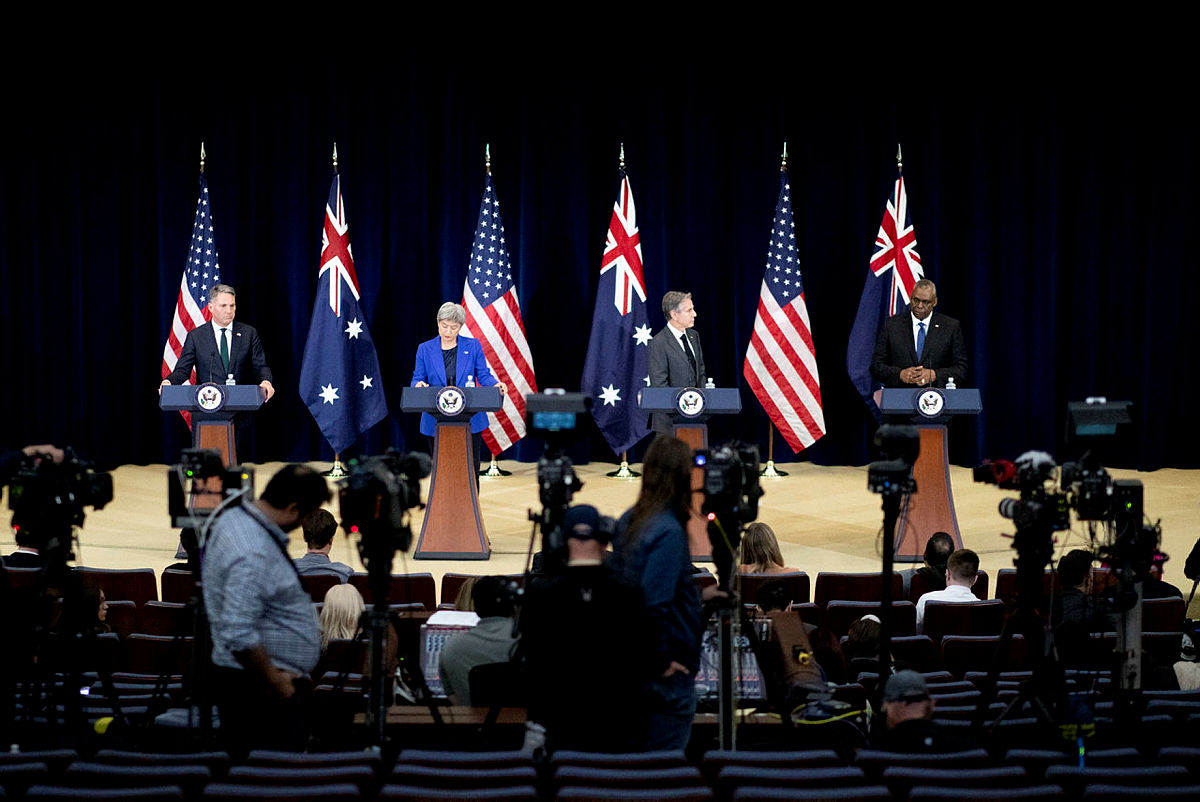
Each AUSMIN meeting, when the foreign and defence ministers from Australia and their American counterparts get together, generally each year, is marked by a communiqué.
These statements signal the matters of mutual agreement and shared concern, and typically mark progress and intent on initiatives of the two nations. Mostly they are fulsome, covering an exhaustive range of current issues. The 2022 communiqué is one such, albeit reorienting towards the Pacific and for the first time referencing indigenous peoples.
That’s what’s new. What’s often interesting are the absences and subtractions from earlier communiqués.
If we cast our eye back over previous outcomes, three differences stand out: a change in tone that reflects how the respective governments think about the world; a shift in emphasis of a specific threat vector; and the priority accorded a recent major initiative.
Let’s take the first: tone. Throughout the 2010s, leading into last year’s communiqué, there was a sense of a darkening world, increasing tensions and a rising existential threat. Democratic values were under pressure.
The focus this year was more on climate change and—as mentioned—on the Pacific and indigenous peoples. There was less of a sense of an existential threat generated by inimical revanchist powers. Instead, there was a return to language reminiscent of 20 years ago, urging Beijing to be a responsible stakeholder.
That language does not resonate with Washington’s recently released national security strategy, which evoked a strong sense of mission, of competing for the future and pushing back against nuclear-armed autocracies.
That suggests communiqué language driven by Australian wordsmithing. That’s not to say there’s a tectonic shift in the fundamentals of Australian defence and foreign policy—there remains the thread of continuity that typically binds consistency into those policies through changes of government.
But we are seeing a reallocation of priorities, a different lens and a purpose that is more about dealing with the messiness of the world. That could suggest a Canberra that sees its role as helping broaden support by addressing issues of regional concern, but risks being more easily distracted and potentially spreading itself more thinly across issues.
The second issue is the prominence accorded cyber. Cybersecurity receives but one mention, early on, along with technology, trade and commerce in a reference to a need for ‘rules of the road’.
That’s in contrast to earlier communiqués that identified it as a real threat, from its first mention in 2009 onwards. In 2011, it merited its own specific statement; in 2012, there were seven mentions; in 2013, five; in 2014, three; and in 2015, five. The 2017 communiqué was unusually brief; even so, cyber was called out as a threat. Once AUSMIN returned after a hiatus in 2020, cyber was mentioned twice and hit a high point in 2021 with eight mentions, including getting its own paragraph.
This year’s apparent lack of interest in cyber at AUSMIN, traditionally a forum for strategic, international relations and defence issues, may be a straw in the wind. Cyber will clearly be an ongoing issue for societies and businesses into the foreseeable future—it is an inherent feature of modern digital and data systems.
But the war in Ukraine raises questions on the value of cyber in conventional warfare. The failure of an anticipated Russian cyber offensive cast doubt on the prospect of a ‘cyber Pearl Harbor’. After all, it was that possibility that prompted the 2011 AUSMIN statement to reference ANZUS itself, should such a cyberattack be directed against either nation.
That, of course, is not to say that cyber has no effect—it evidently does—or that cyber isn’t being used in the Russian effort—it evidently is. And the prospect remains of heightened Russian activity over the coming months.
But it suggests that conventional policy mechanisms continue to struggle with grey-zone activities. Many of those activities go to the nature of government, concern domestic issues, and generally don’t lie within the remit of the defence and foreign policy establishment.
Still, policymakers are not sitting on their hands. We can find part of what may have fallen earlier under the label of cyber in the 2022 communiqué’s language on the need for trusted digital and network infrastructure, and its references to public–private partnerships and to the Quad. That, arguably, helps mature and progress the debate around cyber, by encouraging the civilianising of the defence effort.
The last matter is the absence of half of AUKUS. Yes, the nuclear submarines are there: they get their own paragraph. But there is nothing that explicitly recognises the second—and potentially much more valuable—pillar of AUKUS, the technology accelerator. Ideally that would have been called out.
Instead, technology issues have been either boxed into specific initiatives—such as the guided weapons and explosive ordnance enterprise and space surveillance—or shunted to the Quad, as with the earlier reference to emerging technologies, and conflated with cooperation and collaboration with the region. That’s potentially problematic. The language around working on the defence trade treaty promises more of the same rather than offering the breakthrough needed to access technology and kit.
One possible explanation may be that while Australia stands to be the greatest beneficiary of the AUKUS accelerator, and needs US assistance, it is also the one that needs to do the heaviest lifting and so make, proportionally, the greater investment. The US side may be waiting to see whether Australia is indeed serious about building capability or is content to remain a technology taker, reliant on its inherently extractive economy, helpful friends and good luck.
It can be easy to read too much into the absence of a thing. Yet, attention accorded in communiqués, like the allocation of resources, denotes priorities. This year’s AUSMIN communiqué suggests a government less driven by existential threat, less tolerant of cyber’s challenges and less across the broad technology space. We’ve yet to see whether the shifts noted here are simply short-term decisions of fit or indicative of longer-term trends.

